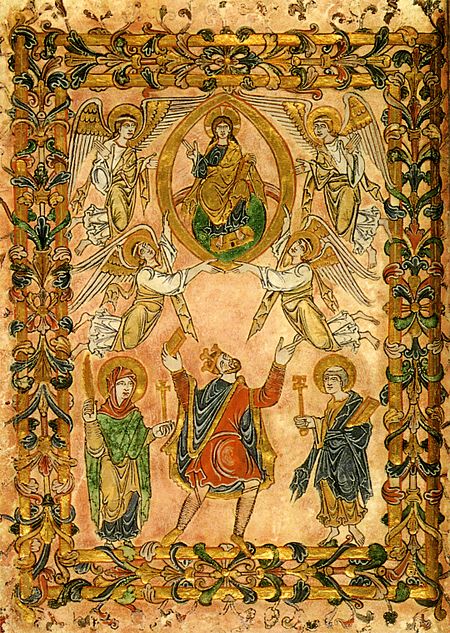Ælfwynn, wife of Æthelstan Half-King facts for kids
Ælfwynn (died 8 July 983) was an important Anglo-Saxon woman. She came from a rich family in Huntingdonshire. Around 932, she married Æthelstan Half-King, a very powerful leader in East Anglia.
Ælfwynn is best known for being the foster-mother to King Edgar. She cared for him after his mother died in 944, when he was just a baby. She had four sons, and her youngest, Æthelwine, became a major supporter of a movement to improve monasteries. Ælfwynn gave her land to help start Ramsey Abbey in 966. She was likely buried there.
Contents
Who Was Ælfwynn?
Ælfwynn was the wife of Æthelstan Half-King. He was called "Half-King" because he was so powerful. People believed that King Edmund I (who ruled from 940–946) and his brother King Eadred (who ruled from 946–955) relied on his advice. Æthelstan was a strong supporter of a movement to improve monasteries. He was also a close friend of Dunstan, who later became a saint and the Archbishop of Canterbury.
Æthelstan married Ælfwynn soon after he became a powerful leader in 932. Her parents are not known, but she came from a wealthy family in Huntingdonshire. A writer from that time, Byrhtferth of Ramsey, said that Ælfwynn's son Æthelwine "had a distinguished lineage on his mother's side." He also wrote that Archbishop Dunstan praised her and her family. Ælfwynn had a brother named Æthelsige.
Her Family and Life
Ælfwynn had four sons: Æthelwold, Ælfwold, Æthelsige, and Æthelwine. In 956, Æthelwold became a leader (called an ealdorman) in East Anglia. This might have been because his father, Æthelstan, was planning to retire and become a monk. That same year, Æthelwold married Ælfthryth. After Æthelwold died in 962, Ælfthryth married King Edgar the Peaceful (who ruled from 959–975). She became the mother of King Æthelred the Unready.
Ælfwynn's second son, Ælfwold, signed important documents as a nobleman (called a thegn) from 958 to 972. Her third son, Æthelsige, also signed documents as a thegn from 958. He was close to King Edgar and served as his chamberlain (a royal assistant) until 963.
Raising a Future King
King Edmund's younger son, Edgar, was born around 943. His mother died in 944. Edgar was then sent to be fostered by Ælfwynn. This showed how powerful and important Ælfwynn was. It also helped Æthelstan's family become even closer to the royal family.
Edgar was likely raised in Huntingdonshire, where Ælfwynn's family had land. Around 958, Edgar gave Ælfwynn a large estate (about ten hides of land) at Old Weston in Huntingdonshire as a thank you. Historians believe that Edgar was greatly influenced by his upbringing with Ælfwynn. He grew up in a household that strongly supported the monastic reform movement. This likely made him fond of monks and determined to improve monasteries himself.
Ælfwynn's youngest son, Æthelwine, was a few years older than Edgar. They probably grew up together. Æthelwine became a powerful leader (ealdorman) of East Anglia in 962. He became the most important non-royal figure in the government after a rival leader died in 983. Æthelsige, Ælfwynn's third son, worked with his brother Æthelwine in East Anglia until he died in 987.
Supporting Monasteries
Æthelwine was called "Dei Amicus," which means "friend of God." This was because he was the main supporter (after King Edgar) of the movement to improve monasteries. In 966, he helped found Ramsey Abbey with Oswald, who was a bishop and later an archbishop.
Ælfwynn strongly supported Ramsey Abbey. Her own lands, including the property Edgar gave her, became part of the abbey's wealth. She might have played a very important role in setting up Ramsey Abbey. Her second son, Ælfwold, also supported the monastic reform. He and his wife gave money to Ramsey Abbey, and he was buried there after he died in 990. Æthelwine also stopped signing documents in 990 and died in 992 after a long illness. He was also buried at Ramsey.
Her Legacy
Ælfwynn died on 8 July 983. Her husband was buried at Glastonbury Abbey. Ælfwynn was probably buried at Ramsey Abbey. The abbey's list of deceased members, called a necrology, recorded her as "our sister." It also noted that she donated the Old Weston estate. Her death was remembered every year on 8 July, the same day as King Edgar's death.
Sources
(subscription or UK public library membership required) (subscription or UK public library membership required) (subscription or UK public library membership required)


